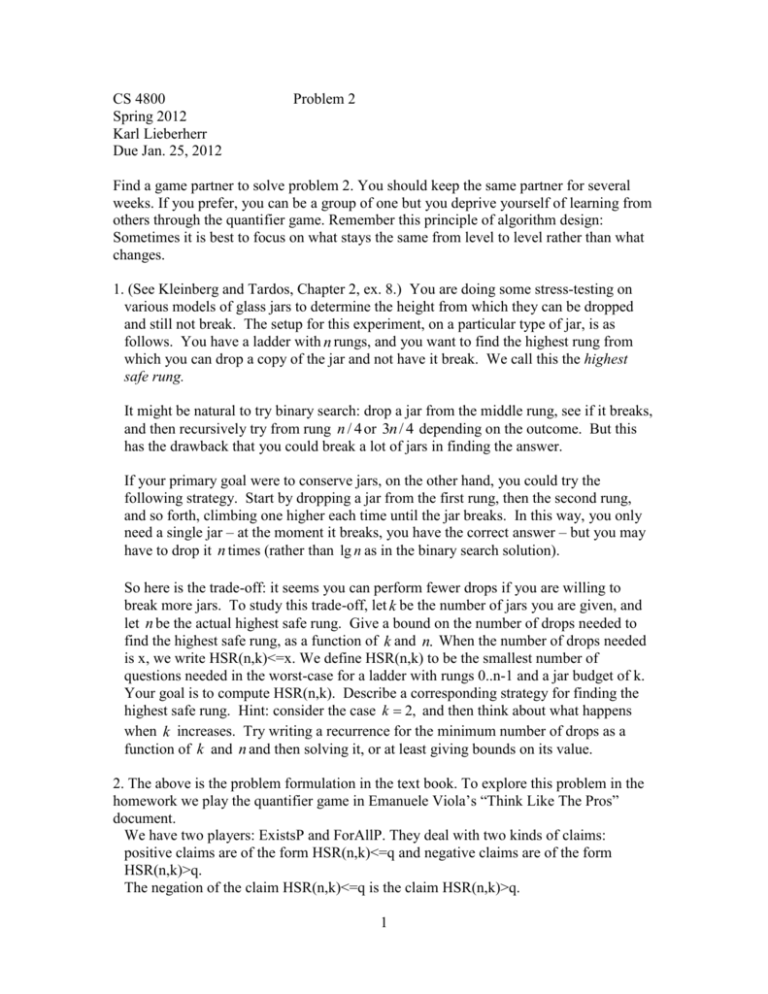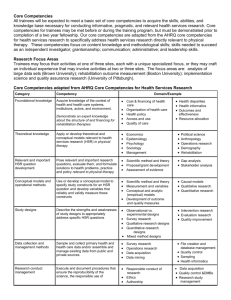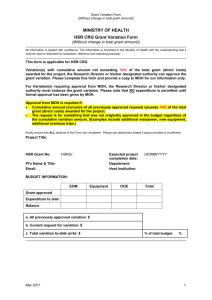COS 423 Problem Set No - College of Computer Science
advertisement

CS 4800
Spring 2012
Karl Lieberherr
Due Jan. 25, 2012
Problem 2
Find a game partner to solve problem 2. You should keep the same partner for several
weeks. If you prefer, you can be a group of one but you deprive yourself of learning from
others through the quantifier game. Remember this principle of algorithm design:
Sometimes it is best to focus on what stays the same from level to level rather than what
changes.
1. (See Kleinberg and Tardos, Chapter 2, ex. 8.) You are doing some stress-testing on
various models of glass jars to determine the height from which they can be dropped
and still not break. The setup for this experiment, on a particular type of jar, is as
follows. You have a ladder with n rungs, and you want to find the highest rung from
which you can drop a copy of the jar and not have it break. We call this the highest
safe rung.
It might be natural to try binary search: drop a jar from the middle rung, see if it breaks,
and then recursively try from rung n / 4 or 3n / 4 depending on the outcome. But this
has the drawback that you could break a lot of jars in finding the answer.
If your primary goal were to conserve jars, on the other hand, you could try the
following strategy. Start by dropping a jar from the first rung, then the second rung,
and so forth, climbing one higher each time until the jar breaks. In this way, you only
need a single jar – at the moment it breaks, you have the correct answer – but you may
have to drop it n times (rather than lg n as in the binary search solution).
So here is the trade-off: it seems you can perform fewer drops if you are willing to
break more jars. To study this trade-off, let k be the number of jars you are given, and
let n be the actual highest safe rung. Give a bound on the number of drops needed to
find the highest safe rung, as a function of k and n. When the number of drops needed
is x, we write HSR(n,k)<=x. We define HSR(n,k) to be the smallest number of
questions needed in the worst-case for a ladder with rungs 0..n-1 and a jar budget of k.
Your goal is to compute HSR(n,k). Describe a corresponding strategy for finding the
highest safe rung. Hint: consider the case k 2, and then think about what happens
when k increases. Try writing a recurrence for the minimum number of drops as a
function of k and n and then solving it, or at least giving bounds on its value.
2. The above is the problem formulation in the text book. To explore this problem in the
homework we play the quantifier game in Emanuele Viola’s “Think Like The Pros”
document.
We have two players: ExistsP and ForAllP. They deal with two kinds of claims:
positive claims are of the form HSR(n,k)<=q and negative claims are of the form
HSR(n,k)>q.
The negation of the claim HSR(n,k)<=q is the claim HSR(n,k)>q.
1
The refutation protocol for positive claims is: ExistsP proposes. ForAllP announces
refutation (which is equivalent to providing a problem). ExistsP provides a decision tree
(more information about decision trees is in part 4). ForAllP checks that it is valid and
of the desired depth. In this case, ExistsP provides a proof that HSR(n,k)<=q through
her decision tree.
Note that the decision tree that ExistsP provides is potentially loaded with useful
information for ForAllP. ForAllP can study the decision tree that ExistsP provides and
potentially figure out the construction principle behind it. Any insight that ForAllP has,
will make him a better player in the game. In this case, ForAllP might want to figure
out the recurrence relation behind the tree of ExistsP.
The refutation protocol for negative claims is: ExistsP claims HSR(n,k)>q. ForAllP
provides a decision tree showing that HSR(n,k)<=q. ExistsP checks that the decision
tree is valid and of the claimed depth. In this case, ForAllP provides a counter example
showing that ExistsP claim is not valid.
We call these two protocols the HSR-main refutation protocol.
ExistsP and ForAllP use the two claim kinds to zero in on the minimum number of
questions needed.
ExistsP creates 5 claims HSR(n,k)<=q or HSR(n,k)>q where k>1!!!!! ForAllP selects a
subset of the claims that he thinks are opposable (refutable or can be strengthened).
HSR(n,k)<=q is a strengthening of HSR(n.k)<=q’, if q’ > q. And HSR(n,k)>q is a
strengthening of HSR(n,k)>q’ if q>q’. For the claims CR that ForAllP refutes, the
refutation protocol HSR-main(ExistsP,ForAllP,CR) is invoked. For the claims that
ForAllP strengthens, say he strengthens HSR(n,k)<=q’ to HSR(n,k)<=q, q’>q, the
refutation protocol HSR-main(ForAllP,ExistsP,HSR(n,k)<=q) is invoked. In other
words, ExistsP tries to refute the strengthened claim.
Note that we could use a different notion of strengthening. HSR(n,k)<=q can be viewed
as a strengthening of HSR(n’,k)<=q, if n>n’. We use the notion from the previous
paragraph.
The claims that ForAllP does not oppose ForAllP has to agree with. The agreement
protocol is invoked.
It is not permitted to repeat claims. Each proposed claim is unique. Each claim is
successfully defended only once but it is still possible to strengthen it.
Reputation points are awarded as follows. Both ExistsP and ForAllP start with 10
points. We would like both ExistsP and ForAllP to be perfect and only propose
optimum claims. Therefore, ExistsP loses 1 of her points to ForAllP, if he successfully
opposes (refutes or strengthens) one of her claims. The same applies to ForAllP.
2
The outcome of the game is a reputation number for ExistsP and ForAllP and, more
importantly, a set of “optimum” claims as determined by the two scholars. It could be
that some of the claims are too strong or too weak and the scholars could not oppose
those claims.
If both ExistsP and ForAllP are “perfect” they will only create optimum claims as
output.
The TA will judge the optimality of the claims produced by each game.
Two smart students playing together will try to make the gap between q and q’ as small
as possible, ideally 1, in the context where we know and actually have a proof for
HSR(n,k)<=q and HSR(n,k)>q’ has not been refuted.
Interesting small claims to start with:
HSR(9,2)<=4,5,6,7
HSR(10,2)<=4,5,6,7
HSR(11,2)<=4,5,6,7
HSR(12,2)<=4,5,6,7
HSR(16,2)<=5,6,7,8,9
Suggestion: Consider claim HSR-main(9,2)<=3 to sharpen your intuition. Then
consider HSR-main(9,2)<=4 to get more ideas. Then consider HSR-main(10,2)=5 to
get more insight.
3. To represent an algorithm for finding the highest safe rung HSR(n,k) for fixed n and k,
we use a restricted programming language that is powerful enough to express what we
need. We use the programming language of binary decision trees. The nodes represent
questions such as 7 (meaning breaks(7)) and the edges represent yes/no answers. We use
the following simple syntax for decision trees based on JSON. The reason we use JSON
notation is that you can get parsers from the web.
A decision tree is either a leaf or a compound decision tree represented byan array with
exactly 3 elements.
// h = highest safe rung or leaf
{ "decision tree" :
[1,{"h":0},[2,{"h":1},[3,{"h":2},{"h":3}]]]
}
The grammar and object structure would be:
DTH = "{" "\"decision tree\"" ":" <dt> DT.
DT = Compound | Leaf.
Compound = "[" <q> int "," <yes> DT "," <no> DT "]".
Leaf = "{" "\"h\" " ":" <leaf> int "}".
3
This approach is useful for many algorithmic problems: define a simple computational
model in which to define the algorithm. The decision trees must satisfy certain rules to be
correct and reasonable algorithms (see the slide below).
4. What to turn in:
1. A first attempt at the solution to the exercise 8, chapter 2. Focus only on the cases
where you are allowed to break at most 2,3 or 4 jars. If you need more help, play an
additional game. Provide a complete definition for the validity of a decision tree.
2. All the exchanges that happened during your game. Show all decision trees that
were exchanged. Give the reputations of ExistsP and ForAllP at the end of the game
and list the claims that are claimed to be optimum. That is the most interesting
output from your game.
3. For each claim that you claim to be optimum, can you actually give a proof that it is
optimum? I.e., it is impossible to refute the claim, for eternity. You need to find a
way to prove that HSR(n,k)>q. Note that this is not as easy as proving a claim of
the form HSR(n,k)<=q which we can prove by giving an explicit decision tree.
4. Play on Piazza (see addendum below). Each team should make a claim and oppose
or agree with one claim on Piazza.
The following slide illustrates how decision trees are used to find the highest safe rung.
Note: Ignore the line starting with (2 y … below. It uses an old format.
Does a legal decision tree for HSR satisfy additional rules? Is what follows complete?
x
Highest Safe Rung Decision Tree
HSR(5,2)=3
2
root
no
yes
y
1
z
4
u
0
1
highest safe rung,
leaf
3
4
2
3
(2 y (1 y h 0 h 1) n (4 y (3 y h 2 n h 3) n h 4))
Properties of decision tree:
1. at most two yes from root to any leaf.
2. longest root-leaf path has 3 edges.
3. each rung 1..n appears exactly once as internal node of the tree.
4. each rung 0..n appears exactly once as a leaf.
1/16/2012
CS 4800
9
There are more important properties of decision trees for HSR: the BST (Binary Search
Tree Property): For any left subtree: the root is one larger than the largest node in the
4
subtree and for any right subtree the root is equal to the smallest (i.e., leftmost) node in
the subtree.
If you need additional help, use Piazza.
Addendum
Multi-criteria or multi-objective problems
The textbook talks about HSR as a multi-objective problem. Here is an introduction to
such problems with the application to HSR.
The motivation and definitions are taken from
http://en.wikipedia.org/wiki/Multiobjective_optimization
and
From a paper by Mihalis Yannakakis
@article{Vassilvitskii:2005:ECS:1132633.1132648,
author = {Vassilvitskii, Sergei and Yannakakis, Mihalis},
title = {Efficiently computing succinct trade-off curves},
journal = {Theor. Comput. Sci.},
volume = {348},
issue = {2},
month = {December},
year = {2005},
issn = {0304-3975},
pages = {334--356},
numpages = {23},
url = {http://dl.acm.org/citation.cfm?id=1132633.1132648},
doi = {10.1016/j.tcs.2005.09.022},
acmid = {1132648},
publisher = {Elsevier Science Publishers Ltd.},
address = {Essex, UK},
keywords = {Pareto set, approximation algorithms, multicriteria problems, multiobjective
optimization},
}
1 Introduction
When evaluating different solutions from a design space, it is often the case that more
than one criterion comes into play. For example, when choosing a route to drive from one
point to another, we may care about the time it takes, the distance traveled, the
complexity of the route (e.g. number of turns), etc. When designing a (wired or wireless)
network, we may consider its cost, its capacity (the load it can carry), its coverage, etc.
5
When solving computational problems we care about their use of resources such as time,
memory, and processors.
Such problems are known as multi-criteria or multi-objective problems. The area of
multi-objective optimization has been extensively investigated for many years with a
number of conferences and books. In such problems we are interested in the trade-off
between the different objectives. This is captured by the trade-off or Pareto curve, the set
of all feasible solutions whose vector of the various objectives is not dominated by any
other solution. The trade-off curve represents the range of reasonable possibilities in the
design space. Typically we have a small number of objectives and we wish to plot the
trade-off curve to get a sense of the design space.
A multi-objective optimization problem has a set of instances, every instance x has a set
of solutions S(x). There are d objective functions, f1 , . . . , fd , each of which maps every
instance x and solution s in S(x) to a positive rational number fj(x, s). The problem
specifies for each objective whether it is to be maximized or minimized. We say that a dvector u dominates another d-vector v if it is at least as good in all the objectives, i.e. uj>=
vj if fj is to be maximized (uj <= vj if fj is to be minimized); the domination is strict if at
least one of the inequalities is strict. Similarly, we define domination between any
solutions according to the d-vectors of their objective values. Given an instance x, the
Pareto set P (x) is the set of undominated d-vectors of values of the solutions. As usual
we are also interested in solutions that realize these values, but we will often blur the
distinction and refer to the Pareto set also as a set of solutions that achieve these values.
Application to HSR:
Instance x=(n,c); n is the number of rungs; c is a positive real number used in the
aggregate function.
Solution s=(k, depth(MIN-HSR-DT(n,k)), c*k+ depth(MIN-HSR-DT(n,k)))
The third component is an aggregate of the first two: it defines how the two-objective
minimization problem is reduces to a single objective minimization problem. MIN-HSRDT gives the optimum decision tree of minimum depth for n and k.
Example:
n=25, c=1:
3-vector = (k, depth, aggregate)
k = minimize: less material cost.
depth = minimize: less employee cost (fewer experiments to make).
aggregate = minimize overall cost. We turn the two-objective optimization problem into a
normal optimization problem.
The claim says: ForAll (n,c) in singleton {(25,1)} Exists a k and a valid decision tree for
(n,k) so that (3,5,8) is the element of the Pareto set where c*k+ depth(MIN-HSRDT(n,k)) is minimum over all k and valid decision trees for (n,k).
The Pareto set contains one element for each value of k:
6
(5,5,10)
(4,5,9)
(3,5,8)
(2,7,9)
(1,24,25)
We would choose the element where the aggregate is minimum: (3,5,8). What is MINHSR-DT(25,3)?
Go to Piazza and make a claim of the form: For n,c, the element of the Pareto set where
the third component is minimum over all k<=n and legal decision trees, is (k, depth,
aggregate).Choose n to be between 30 and 40.
These numbers are big enough that you need an implementation in your favorite
programming language. You not only need a program that creates valid decision trees but
also one that checks whether a given tree is valid, i.e., correctly computing the highest
safe rung.
Each team should propose one claim. Try to avoid duplicating claims: there are plenty of
claims to choose from.
7






